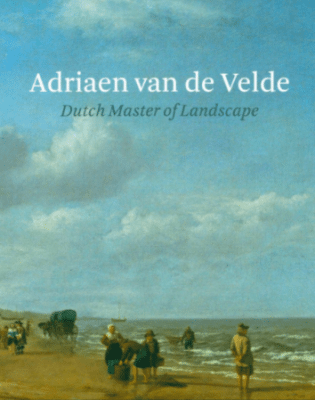Adriaen van de Velde (1636–1672) has long been admired by art historians for his delicate landscapes with their sensitive lighting and exquisite staffage, but the Dutch artist is not known with a wider audience. An excellent exhibition at the Rijksmuseum in Amsterdam and the Dulwich Picture Gallery in London – where the reviewer saw it – has hopefully changed this. As the son of the more famous Willem van de Velde and brother of the younger Willem, Adriaen was destined to become a marine painter. His works, however, do not feature ships on choppy seas but rather more steady landscapes, beachscapes, pastoral scenes, animals and a few religious works. Described by Jacob Houbraken as a child prodigy, Adriaen’s earliest datable works are indeed already masterpieces: The Beach at Scheveningen, dated 1658, is simply mesmerising, especially since the painting was created when Van de Velde was only twenty-two years old. Once you notice the man in the lower right corner, seen from the back and gazing out at the sea, it is impossible not to be intrigued by the vast water ahead of him. This early painting is just one of the highlights of this first ever exhibition dedicated to Adriaen van de Velde. Etchings were deliberately not shown but the 24 paintings and 36 drawings on display offered a comprehensive overview of the artist’s skills as a “Dutch master of landscape.” The majority of the works were taken from the Rijksmuseum’s holdings (nine of which were only shown in Amsterdam), supplemented by loans from over twenty lenders, including museums and private collectors. Many of the paintings were reunited for the first time with their preparatory drawings since they left Van de Velde’s workshop, as well as independent sheets being shown for the first time. The prominence that was given to the drawings was refreshing compared to other exhibitions where they are presented as secondary to the paintings. Together, this superb selection of Van de Velde’s drawings and paintings demonstrated the perfect balance of nature and man in his works. His pastoral landscapes are populated by numerous wonderfully rendered figures which could be character studies in their own right. The man in the lower right of The Beach at Scheveningen springs to mind again.
The richly-illustrated catalogue explores Adriaen van de Velde’s career and works through a scholarly introduction authored by Bart Cornelis and 36 catalogue entries describing 60 of his best works, roughly divided between Bart Cornelis (former Deputy Editor of the Burlington Magazine; now Curator of Dutch and Flemish Paintings 1600-1800 at the National Gallery, London) for the paintings and Marijn Schapelhouman (former Curator of Drawings at the Rijksmuseum, Amsterdam) for the drawings. The introduction brilliantly guides the reader through the artist’s life as well as his working methods, pupils, followers, collaborations and legacy. Besides dispelling myths regarding Van de Velde’s training, this extended essay casts insightful light onto Van de Velde’s place in the art market and ‘the blue problem.’ A serious conservation issue whereby the blue pigments used by Van de Velde have faded into yellow, this discoloration in Van de Velde’s paintings is now seen as a signature trait which can even confirm their attribution. The individual catalogue entries are elaborate with up to ten comparative illustrations – however, some of them are hardly legible because of their small size. Parallels are drawn with related paintings, preparatory drawings and even reproductive prints.
With Van de Velde’s oeuvre largely established – thanks to the artist signing and dating many of his works as well as a recent doctoral dissertation (Marietta Frensemeier, Studien zu Adriaen van de Velde, Aachen, 2001) – the exhibition’s greatest contributions lay in its clever balance of paintings and drawings as well as the rich analysis of Van de Velde’s working methods. It was a treat to see one of Van de Velde’s most famous paintings, The Hut, surrounded by four of its preparatory sketches, including a compositional study in pen and ink of the cottage as well as additional chalk studies of the peasants and animals populating the pastoral scene. Through this group of works we can almost look over Adriaen’s shoulder and see how he worked from conception to completion: from rapid compositional sketches to individual figure and animal studies and finally the painting.
Equally, the many nude studies which Van de Velde fluently drew in either red or black chalk are highlights within his oeuvre. The male and female models – and even the specific poses adopted by them – can be found in several other works, demonstrating that Van de Velde treasured these sheets and kept them in his workshop to be re-used for different compositions. Surprisingly, a nude study of a seated woman in Oxford served as the model for the (naturally clothed) Virgin in one of Van de Velde’s rare religious works, The Annunciation from the Rijksmuseum, which was unfortunately only on display in Amsterdam. At first sight these apparently completely unrelated works highlight Van de Velde’s working methods in addition to revealing an important aspect of his personal life: Adriaen was a Catholic and probably created this biblical scene for one of Amsterdam’s hidden churches at a time when Catholicism was banned there. Both the exhibition and the catalogue do great justice to this relatively unknown landscape artist with a new admirer being found in the reviewer. Despite his short career – he died aged only thirty-five – Adriaen van de Velde was a true master of landscape as superbly shown in Amsterdam and Dulwich.
An Van Camp
Ashmolean Museum, Oxford
